
Privacy curtains
Bacteria, viruses, and other microbes have a Spiderman-like superpower to stick to just about any surface, according to the Journal of Clinical Microbiology. In a hospital, because of the constant flow of patients, healthcare workers, and visitors in and out of rooms, frequently used objects can build up huge amounts of bacteria and other microbes. One surprisingly germy object? The privacy curtains that surround patients’ beds, reports a recent study in the American Journal of Infection Control. Researchers tracked the contamination of ten freshly cleaned curtains and within two weeks, nearly 90 percent of the curtains had been colonized by potentially dangerous antibiotic-resistant Staphylococcus aureus bacteria (MRSA). According to a 2013 study, about one in 12 adults in hospitals across Canada have MRSA or another superbug.
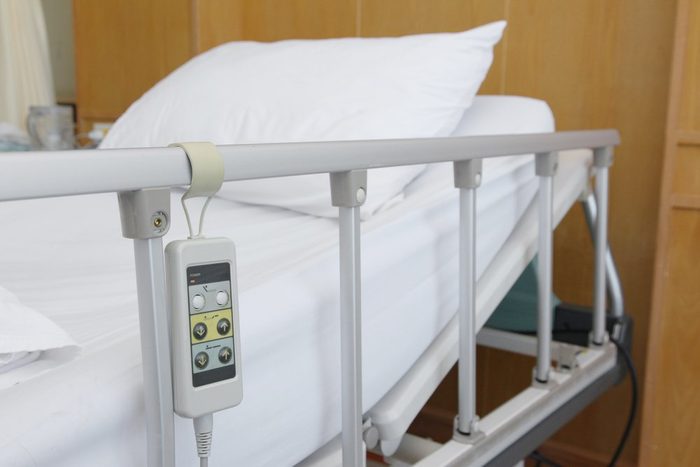
Bed rails
Bacteria and other microbes can live for weeks on stainless steel and other hard surfaces in hospitals, studies show. MRSA can stick around for nearly a year, and certain types of bacteria such as diarrhea-inducing Clostridium difficile can live for months. Both patients and healthcare workers handle bed rails, which have been found to harbor large amounts of potentially sickening bugs. Bed rails are unlikely to be cleaned during your stay in a hospital room—so consider wiping them down (or asking a family member or friend to do so) with a disinfectant wipe daily. “I would,” says Charles P. Gerba, PhD, a renown germ researcher and microbiologist at the University of Arizona. “These objects get recontaminated all the time, so this is a good idea.”
Hospitals aren’t the only places full of germs. These are the dirtiest objects you touch on any given day.
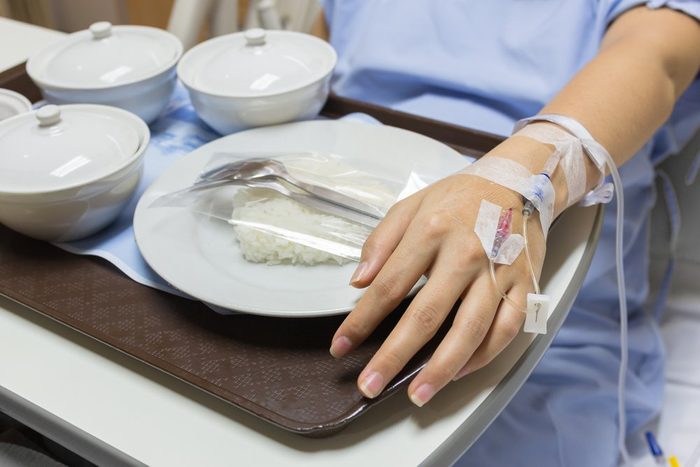
Over-the-bed carts
That little rolling cart you set your lunch tray and water cup on when you’re in a hospital bed is what researchers call a “high-touch” object. That means bacteria is getting deposited on—and picked up from—those surfaces multiple times a day.
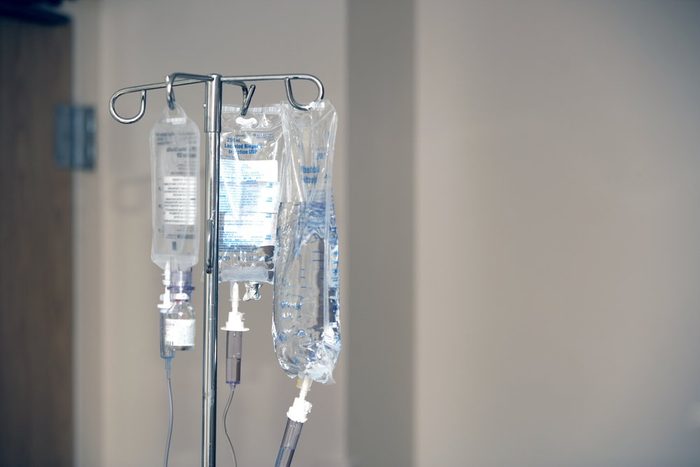
The IV pole
The metal poles on the rolling cart nurses hang IV bags from—the ones that healthcare workers and patients alike grab to drag the bag around—have been found to harbor colonies of illness-causing bacteria such as MRSA and antibiotic-resistant Enterococci bacteria (VRE), according to a 2012 study in the Journal of Clinical Microbiology. Infections caused by antibiotic-resistant bacteria, or “superbugs,” are hard to treat and extremely dangerous because common medications won’t kill them. To help combat infection, Dr. Gerba recommends patients use medical-grade hand sanitizer at regular intervals throughout the day. “It may be hard to handwash often, especially post-surgery or if someone is very ill,” he says. “Using hand sanitizer is such an easy thing to do and it is very effective at killing most germs.”
Feeling squeamish? This is why some people faint when they see blood.

Elevator buttons
Doctors, nurses, and other healthcare staff are constantly using elevators, and any germs they have on their hands—picked up from patient’s themselves, IV poles, bed rails, or other bacterial hot spots—can be transferred to the call button. When researchers swabbed 48 different elevator buttons for a study in the journal Antimicrobial Resistance & Infection Control, they found that more than one-third were contaminated by MRSA. Other illness-causing bacteria found on the buttons included diarrhea-causing E. coli and Acinetobacter bugs that can cause pneumonia and meningitis. “Elevator buttons are one of the neglected sites in a hospital, often not cleaned or disinfected and can become a potential site for bacterial colonization,” the researchers reported.
Try to remember to sanitize your hands after riding a hospital elevator—or, if you have a tissue or napkin handy, use that to push the buttons, then dispose of it. According to one survey, people aren’t washing their hands nearly as often as they should.

Armrests on visitor’s chairs
When your family and friends come to visit, ask them to wipe down the visitor’s chairs with a disinfectant wipe before taking a seat. Researchers studying hospital furniture and equipment found that a risky level of antibiotic-resistant Enterococci bacteria that can cause difficult-to-cure wound infections or urinary tract infections.
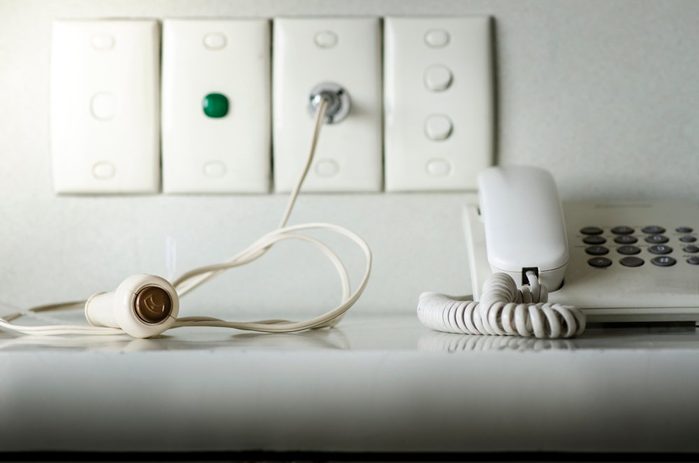
Telephones
Typically, hospital telephone sets aren’t cleaned as frequently as you might hope, say researchers, despite the fact that they are handled often by both patients and healthcare workers. A recent study published in the journal Antimicrobial Resistance and Infection Control found that an “alarming” number of phones in intensive care units were contaminated by drug-resistant bacteria. Clearly, running a disinfectant wipe over the phone in your hospital room—and/or sanitizing your hands after each time you use it—is a smart move.

Water faucets
Hard surfaces of hospital bathrooms are frequently contaminated with fecal matter and other bacteria from droplets expelled from open toilets during flushing. But you should assume that any faucet in a hospital room—even the ones outside the restroom—is germy. Faucet handles are one of the high-touch objects that hospital researchers have found to be contaminated with illness-causing bacteria.
You could try using a paper towel to turn the faucets off after washing your hands, or even better, says Dr. Gerba, “use a hand sanitizer after you wash your hands.”

Door handles
Healthcare workers, visitors, and patients must touch door handles when moving from room to room around a hospital ward. Studies have suggested that up to 30 percent of door handles may be contaminated by MRSA. A good reminder to sanitize your hands when entering or leaving any hospital room.
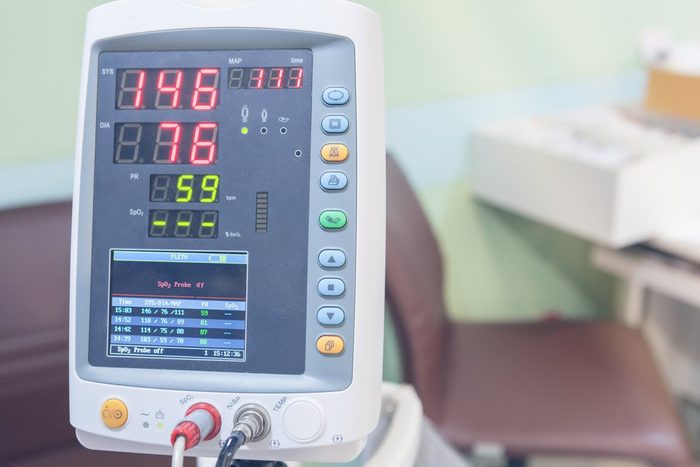
Anything your nurse uses often
Anything that’s touched frequently by multiple people is going to build up a nice collection of bacteria. Whenever possible, avoid touching supply carts, touch-screen equipment, keyboards, and other objects that are used by healthcare workers throughout the day. And, as Dr. Gerba recommends, remember to use hand sanitizer at regular intervals whenever you’re in a hospital. Now check out 10 things doctors secretly wish they could tell you.
